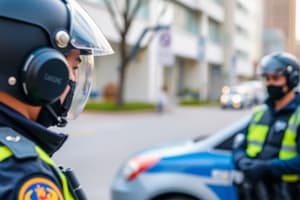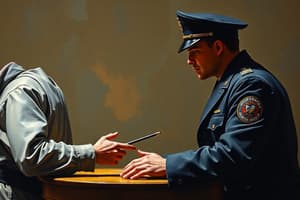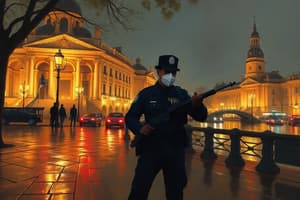Podcast
Questions and Answers
Which of the following is NOT a core operational strategy of law enforcement?
Which of the following is NOT a core operational strategy of law enforcement?
- Community Policing (correct)
- Criminal Investigation
- Routine Incident Response
- Preventive Patrol
What is the primary purpose of 'Compstat' as a crime analysis and management process?
What is the primary purpose of 'Compstat' as a crime analysis and management process?
- To identify and arrest criminals
- To provide training and support to police officers
- To increase police presence in high-crime areas
- To predict where and when crimes will occur (correct)
Which of the following is NOT considered a 'Quality of Life Offense'?
Which of the following is NOT considered a 'Quality of Life Offense'?
- Vandalism
- Prostitution
- Panhandling
- Robbery (correct)
What is the most common type of call received by law enforcement agencies?
What is the most common type of call received by law enforcement agencies?
Which of the following is an example of a support service provided by law enforcement agencies?
Which of the following is an example of a support service provided by law enforcement agencies?
Why is preventive patrol considered the dominant policing strategy?
Why is preventive patrol considered the dominant policing strategy?
In what way does Compstat help improve law enforcement effectiveness?
In what way does Compstat help improve law enforcement effectiveness?
What is the primary focus of criminal investigations?
What is the primary focus of criminal investigations?
Which of the following steps is NOT included in the "ADAPT" acronym for a first officer responding to a crime scene?
Which of the following steps is NOT included in the "ADAPT" acronym for a first officer responding to a crime scene?
In which policing era did police operate with a strong emphasis on crime fighting and maintaining a strict adherence to the law?
In which policing era did police operate with a strong emphasis on crime fighting and maintaining a strict adherence to the law?
Which of the following accurately describes the 'Watchman' style of policing ?
Which of the following accurately describes the 'Watchman' style of policing ?
According to the provided information, what is the primary reason that police officers prioritize saving lives over preserving evidence at a crime scene?
According to the provided information, what is the primary reason that police officers prioritize saving lives over preserving evidence at a crime scene?
Which policing style would be MOST likely to intervene in a situation where a group of individuals is engaging in loud, disruptive behavior that is not illegal?
Which policing style would be MOST likely to intervene in a situation where a group of individuals is engaging in loud, disruptive behavior that is not illegal?
Which of the following is NOT a characteristic of police subculture?
Which of the following is NOT a characteristic of police subculture?
What is the primary purpose of 'fusion centers' in the context of terrorism?
What is the primary purpose of 'fusion centers' in the context of terrorism?
Which of the following factors is NOT a significant influence on police discretion?
Which of the following factors is NOT a significant influence on police discretion?
Which statement BEST describes the 'service style' of policing?
Which statement BEST describes the 'service style' of policing?
Why is 'boundaryless policing' essential for counter-terrorism efforts?
Why is 'boundaryless policing' essential for counter-terrorism efforts?
What constitutes the most prevalent type of call received by law enforcement agencies?
What constitutes the most prevalent type of call received by law enforcement agencies?
According to the content, what is the main purpose of police accreditation?
According to the content, what is the main purpose of police accreditation?
What is the primary challenge women in law enforcement face?
What is the primary challenge women in law enforcement face?
Flashcards
First Responding Officers
First Responding Officers
Officers who provide assistance, secure the scene, and begin preliminary investigations.
ADAPT
ADAPT
An acronym for the steps First Responding Officers take: Assess, Detain, Arrest, Protect, Take notes.
Political Era of Policing
Political Era of Policing
The period from 1840-1930 where police had close ties with public officials, often leading to corruption.
Watchman Style
Watchman Style
Signup and view all the flashcards
Legalistic Style
Legalistic Style
Signup and view all the flashcards
Predictive Policing
Predictive Policing
Signup and view all the flashcards
Compstat
Compstat
Signup and view all the flashcards
Quality of Life Offenses
Quality of Life Offenses
Signup and view all the flashcards
Preventive Patrol
Preventive Patrol
Signup and view all the flashcards
Emergency Response
Emergency Response
Signup and view all the flashcards
Criminal Investigation
Criminal Investigation
Signup and view all the flashcards
Core Operational Strategies
Core Operational Strategies
Signup and view all the flashcards
Support Services
Support Services
Signup and view all the flashcards
Service Style
Service Style
Signup and view all the flashcards
Police Subculture
Police Subculture
Signup and view all the flashcards
Discretion
Discretion
Signup and view all the flashcards
Factors Influencing Discretion
Factors Influencing Discretion
Signup and view all the flashcards
Fusion Centers
Fusion Centers
Signup and view all the flashcards
Police Ethics Training
Police Ethics Training
Signup and view all the flashcards
Purpose of Policing
Purpose of Policing
Signup and view all the flashcards
Boundaryless Policing
Boundaryless Policing
Signup and view all the flashcards
Study Notes
Preventing Crime
- Police ability to prevent crime relies on predicting when and where crimes will occur.
- Allocating resources strategically is important.
- Crime mapping, such as Compstat, is useful to help with resource allocation.
- Compstat is a crime analysis and police management process.
- Compstat was developed by the NYPD in the mid-1990s.
- In 1994, NYPD's Police Commissioner William Bratton implemented Compstat.
- Compstat successfully drove down crime by improving management, statistics, and accountability levels.
Preserving Peace
- Police officers perform various tasks to maintain peace, including handling domestic disputes and ensuring tranquility.
- Quality-of-life offenses (minor violations like petty crimes) negatively impact community residents and businesses.
- Such offenses can lead to physical disorder reflecting social decay (e.g., panhandling, prostitution, vandalism).
Providing Services
- About 70% of 911 calls are handled by police.
- Police manage both emergency & non-emergency calls (barking dogs, loud music, lost/found items, accidents, medical emergencies, and neighbor disputes).
- Five core operational strategies are present: 1) preventative patrol, 2) routine incident response, 3) emergency response, 4) criminal investigations, and 5) problem-solving.
- Support services like dispatch, training, and record-keeping also contribute.
Preventive Patrol
- A dominant policing strategy involving uniformed officers patrolling public areas.
- Patrol work is a major factor in local and state agency spending.
- Emergency responses are needed during crimes in progress, serious injuries, natural disasters, and any situation jeopardizing human lives.
Criminal Investigations
- Criminal investigations receive considerable media attention, but they only account for a small portion of police work.
- Police must collect, prepare, and present evidence to determine what happened and who was responsible.
- First responders establish safety, assist injured individuals, secure the scene, and begin initial investigations.
- A crucial rule for crime scenes is maintaining safety.
- On-site evidence collection helps determine and explain events.
- A vital element of the process is adhering to guidelines for crime scene analysis.
Managing Police Work
- Police management involves administrative tasks such as controlling, directing, and coordinating personnel and resources.
- Four policing eras are notable in United States history: 1) Political (1840-1930), 2) Reform (1930-1970), 3) Community Policing Era (1970s-today), and 4) New Era (2001-today post-9/11).
Policing Styles
-
Community-oriented policing: A partnership approach between police and the community, crucial for crime prevention and problem solving.
-
Three basic policing styles: watchman, legalistic, and service styles.
-
The watchman style focuses on maintaining order, intervening in disruptive behavior, and balancing discretion.
-
Legalistic style adheres to enforcing laws strictly.
-
Service-style prioritizes community needs alongside enforcing laws.
Police Subculture
- Police subculture includes values, beliefs, and behavioral norms.
- Police officers internalize the values through training.
- Subculture is sometimes characterized by distinctions between "us" versus "them", or "the courts have tied our hands"; and police cynicism.
- Focus is on crime fighting instead of community needs.
Terrorism's Impact on Policing
- 9/11 attacks and other instances of terrorism affected police departments, with more resource allocation now going to terrorism-related efforts.
- Borderless policing, which facilitates information sharing between jurisdictions, is now crucial.
- Fusion centers are now used to analyze information collected from various agencies and identify criminal patterns.
Discretion
- Discretion in policing may involve varying choices based on specific circumstances/ situations.
- Factors influencing officer discretion include their background, values, the suspects characteristics, attitude, and department policies.
- Ethics and training are integrated into law enforcement training programs.
Accreditation and Professionalism
- Accreditation aims to enhance police service by providing standards and improving professionalism.
Policing Opportunities
- There have been opportunities for women and minorities in the police force to rise to more important/higher roles, which is expanding.
- Efforts from law enforcement and training have begun to implement policies to deal with issues concerning female officers' strain and isolation due to family and social concerns.
Policing Purpose
- Police purpose includes enforcing laws, investigating crimes, apprehending perpetrators, preventing crimes, maintaining peace, and providing community-related services.
Reactive vs. Proactive Policing
- Reactive policing responds to problems after they occur.
- Proactive policing aims to prevent problems before they happen.
Apprehending Offenders
- Offenders can be apprehended while committing a crime, shortly after, or with the help of an extensive investigation.
Preventing Crime
- Crime prevention focuses on preventing criminal activities proactively, not simply reacting after a crime occurs.
- This approach entails reducing or removing opportunities for crime and lessening the rewards and fear of crime.
Studying That Suits You
Use AI to generate personalized quizzes and flashcards to suit your learning preferences.




